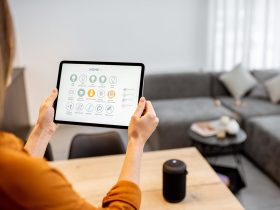Last month, another aspiring mobile payment service launched in Germany: Google Pay. It is hoped that it will be the breakthrough for mobile payments, although this breakthrough is something that’s been predicted repeatedly since 2012. Indeed, recent years have seen a number of pioneers trying to bring about widespread adoption of smartphone payments – it’s just it hasn’t really caught on among German consumers. Now with Google entering the German market with its payment service, the first major international tech giant is attempting to make German wallets obsolete.
Germany is the 19th country where people can pay using Google Pay – but only if they have an Android smartphone (running Lollipop or later) with an NFC (near-field communication) chip. You also need a Visa or Mastercard issued by Commerzbank, Comdirect, N26, or Wirecard’s Boon – although at least with the latter you can simply add it as a prepaid credit card and skip the lengthy identity verification process (known as the KYC – know your customer – process). The big German high-street banks, including Sparkasse and Volksbank, do not plan on supporting Google Pay. Instead, they want to launch their own solutions in the fall. Baden-Württembergische Bank (BW-Bank) and Revolut are also planning to follow suit.
Besides the still very limited number of banks that will allow customers to use Google Pay at all in Germany, it will be met with muted interest anyway as cash is still king there. According to Germany’s Bundesbank [link in German], last year cash still accounted for 74% of transaction volumes. While cash transactions in terms of value fell below 50% for the first time in 2017, at 48% they are still very high. In a country where almost three quarters of the population have a credit card, but only 5% actually use them, even Google Pay may not achieve the desired breakthrough despite its extremely simple consumer onboarding process.

Onboarding
To use Google Pay you first need to download the app from the Play Store and then set it up – all pretty straightforward. You then need to add your credit or debit card number, validity date, and security code as well as provide your address and telephone number. If your card has been issued by a participating bank, you can start using Google Pay right away to pay for items at the checkout POS system. All other cards can only be used with Google Pay to pay for e-commerce purchases. When making a payment a virtual card number in the form of a token is transmitted to the reader, not your actual credit card details. For Google Pay to work at the checkout, all that’s really needed is for the merchant to accept credit card payments and have an NFC-equipped card reader. In Germany around 475,000 readers are NFC ready, although sadly not all of them are compatible automatically with Google Pay. Tests found repeated instances of readers not working, even though contactless payment was possible in principle.
This is down to the readers’ configuration. They need to support CDCVM (the Consumer Device Cardholder Verification Method), but the issue is that the EMV (Europay International, Mastercard, and Visa) standard supports a range of CVMs (consumer verification methods). When paying for low-value items contactlessly, no CVM is used. This method simply allows the customer to tap to pay, with no need to enter a PIN for amounts under €30 (or $30). But as Google Pay authenticates transactions such as using a fingerprint, CDCVM is used. The smartphone takes care of authentication, not the reader. This means that the transaction limit is removed as the smartphone always authenticates transactions. But for this to work in practice, the card readers must be configured and support CDCVM.
Security and privacy settings
Google Pay is secure – at least according to Google. With Google Pay your card details aren’t stored on the smartphone itself, but encrypted on Google’s servers. Google says that nobody can access this information if a device gets lost or stolen. When it comes to data protection, Google explains that the data is only used to improve customer satisfaction with Google Pay. But let’s not forget that practically any regular credit or debit card now lets you use the underlying technology (i.e. contactless payment via NFC) without needing to involve a mobile device, and that this is considered secure.
Conclusion
While the launch of Google Pay is in itself a flash in the pan, it is an important step in the digitization of payment transactions. And this digitization is what it should be all about. It makes no sense to differentiate between mobile or e-commerce payments as ultimately it is always about a payment process – and this is just a means to an end. Consumers want to shop without needing to think about the payment process – with the best one happening invisibly in the background. In this respect, we’re going to see many different payment transaction models emerging. Mobile payment is just one of them, payment using Bitcoins is another – but the journey continues.
This post is also available in: Italian













